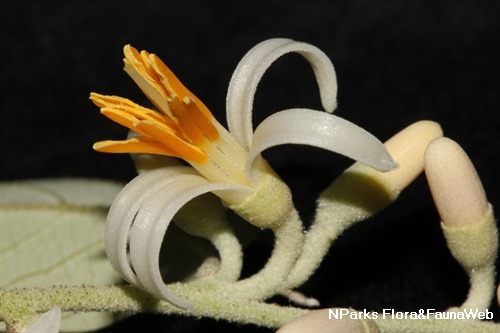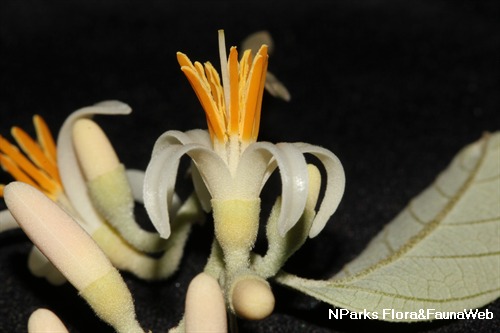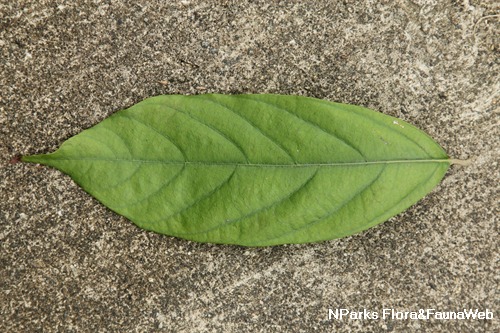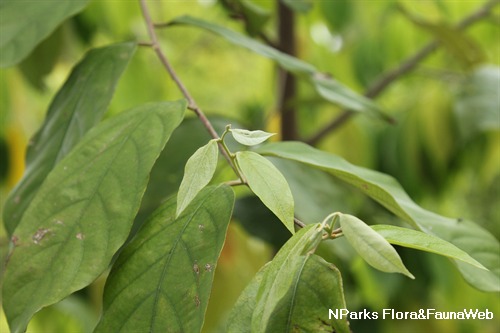
Name
Classifications and Characteristics
| Plant Division | Angiosperms (Flowering Seed Plants) (Dicotyledon) |
|---|---|
| Plant Growth Form | Tree (Big (>30m)) |
| Lifespan (in Singapore) | Perennial |
| Mode of Nutrition | Autotrophic |
| Plant Shape | Irregular |
| Maximum Height | 34 m |
Biogeography
| Native Distribution | India, Myanmar, Thailand, Indochina, Sumatra, Peninsular Malaysia, Singapore, Java, and Borneo |
|---|---|
| Native Habitat | Terrestrial (Primary Rainforest, Secondary Rainforest, Freshwater Swamp Forest) |
| Preferred Climate Zone | Tropical, Sub-Tropical / Monsoonal |
| Local Conservation Status | Native to Singapore (Critically Endangered (CR)) |
Description and Ethnobotany
| Growth Form | It is a tree up to 34 m tall, with small buttresses. The plant excretes an aromatic and resinous substance (benzoin) when bruised. |
|---|---|
| Foliage | Its spirally arranged, stalked leaves have leaf blades that are egg-shaped to oblong or lance-shaped, and 6–20 by 2–9 cm. They also have white, woolly, star-like hair covering its undersides. |
| Flowers | Its flowering shoot is 13–20 cm long, and develops at the end of leafy twigs or the leaf axils. Each flowering shoot bears stalked, fragrant, white flowers. |
| Fruit | Its indehiscent fruits are flattened-round and 2–3.8 cm wide. Each fruit contains 1 or 2 seeds that are dull pale brown and 1.5–2 cm wide. |
| Habitat | It grows in mixed primary and disturbed forests, mostly on fertile soil, from 100–1,600 m altitude. It occurs locally in Mandai forests. |
| Associated Fauna | Its flowers are insect-pollinated. Its fruits and seeds are eaten and dispersed by mammals. |
| Cultivation | It can be propagated by seed. |
| Etymology | Greek Styrax, derived from a Semitic name for these resin-producing plants; English benzoin, from an Arabic vernacular word, aromatic gum, referring to the benzoin resin the tree produces |
| Ethnobotanical Uses | Others: The plant yields a red benzoin that is used as incense, and in the flavour, fragrance, and pharmaceutical industries. |
Landscaping Features
| Landscaping | It is suitable for growing in parks for its white fragrant flowers and leaves with a silvery-white underside. |
|---|---|
| Desirable Plant Features | Ornamental Flowers, Ornamental Foliage, Fragrant (Flowers) |
| Landscape Uses | Parks & Gardens, Riverine |
Fauna, Pollination and Dispersal
| Pollination Method(s) | Biotic (Fauna) |
|---|---|
| Seed or Spore Dispersal | Biotic (Fauna) (Vertebrates (Other Mammal)) |
Plant Care and Propagation
| Light Preference | Full Sun |
|---|---|
| Water Preference | Lots of Water, Moderate Water |
| Plant Growth Rate | Moderate |
| Rootzone Tolerance | Moist Soils, Well-Drained Soils, Fertile Loamy Soils |
| Maintenance Requirements | Moderate |
| Propagation Method | Seed |
Foliar
| Foliage Retention | Evergreen |
|---|---|
| Mature Foliage Colour(s) | Green, Silver / Grey |
| Mature Foliage Texture(s) | Leathery |
| Foliar Type | Simple / Unifoliate |
| Foliar Arrangement Along Stem | Alternate, Spiral |
| Foliar Attachment to Stem | Petiolate |
| Foliar Shape(s) | Non-Palm Foliage (Lanceolate, Elliptical, Oblong) |
| Foliar Venation | Pinnate / Net |
| Foliar Margin | Entire |
Floral (Angiosperm)
| Flower & Plant Sexuality | Bisexual Flowers |
| Flower Colour(s) | White |
|---|---|
| Flower Grouping | Cluster / Inflorescence |
| Flower Location | Axillary, Terminal |
Fruit, Seed and Spore
| Mature Fruit Colour(s) | Green - Light Green |
|---|---|
| Mature Fruit Texture(s) | Smooth |
| Fruit Classification | Simple Fruit |
| Fruit Type |
Image Repository
Others
| Master ID | 30443 |
|---|---|
| Species ID | 4752 |
| Flora Disclaimer | The information in this website has been compiled from reliable sources, such as reference works on medicinal plants. It is not a substitute for medical advice or treatment and NParks does not purport to provide any medical advice. Readers should always consult his/her physician before using or consuming a plant for medicinal purposes. |









